Understanding Evolution - Origin of Limbs
This entry is part of a collection on Understanding Evolution. For other entries in this collection, follow that link.
I recently came across and answered a question on Quora that reveals a misunderstanding I've seen before over evolution. The question was If theory of evolution is true, why aren't there more semi-evolved species with hands coming out of their skulls or other half-baked monstrosities?. It seems to be that some people think that evolution works by creating partially complete versions of what will later be a fully fledged feature of an organism. Obviously, that's not the case. So I figured it might help to explain how a trait like our limbs actually did evolve.
Evolution doesn't have any foresight or planning. Every organism that has ever lived is both the end result of all the evolutionary history leading up to it, and a transitional form to whatever it's future descendants might look like (assuming its lineage doesn't go extinct).
In contrast to what that Quora question implied, evolution doesn't work like this:
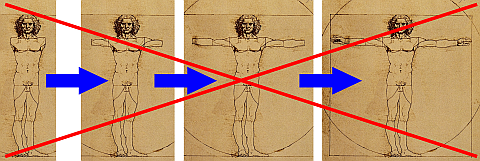
Evolution didn't provide us with a partial arm in anticipation of a fully developed arm down the road. We didn't sprout a bicep, then a forearm, and finally a hand to complete our limbs. Genetics just doesn't work that way. If an organism doesn't have any limbs to begin with, it's not going to create a monstrosity with a partial human limb. Evolution only works incrementally, and every step has to be functional, or else the organism won't survive to reproduce.
So, if our ancient ancestors didn't have limbs, but we do now, how did it happen? What were the types of changes that were small enough to be possible through genetic mutation, but useful enough to benefit those organisms?
First of all, our ancient ancestors looked something like this:
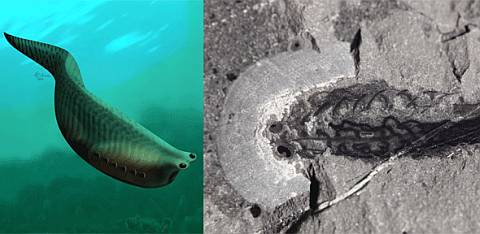
Just to be clear, it's very unlikely that that's actually our direct ancestor. It's probably a cousin of our direct ancestor. So, it's more like our great-great-great aunt/uncle. But, just like you're more similar to your human aunts and uncles than to unrelated strangers, our ancestors were probably pretty similar to that creature. And of course, you can go back and find even simpler ancestors that are more ancient, but I didn't want to go through our entire evolutionary history for this entry.
So, that critter is a very early chordate. It's got some of the same features we do - eyes, a brain, a 'spinal' cord, etc. But it's also missing some of the features we have now - a jaw, bones, and most notably for this discussion, limbs. So, what could those first rudiments of limbs have looked like? Probably something like this:

Now, I'm going to be completely honest. That picture is informed speculation based on studying modern animals, genetics, and embryology, since no fossils have been found preserving that type of soft tissue, but it should be clear how skin folds leading to fins would have been a pretty small mutation that would have benefitted our swimming ancestors. From that creature in the top of the image, it's also a small step to then split up those now existing fins into several independent fins - giving those organsims more freedom in how to use those fins.
Once our ancestors had simple fins, then it was a series of small incremental steps to get to more complex fins, like shown in this next picture:

I like this one because it also shows the branching nature of evolution. It wasn't just primitive fins in a straight line to our direct ancestors. As those populations split up, each newly independent population took its own evolutionary path, each finding different strategies for modifying fins. In one particular lineage (L), it created a fin with fairly robust bones.
Now, that lineage kept on splitting, too. Some populations remained in aquatic habitats, so that today you can still find coelocanths which have fins with robust bones like that. But some of the populations became increasingly specialized for amphibious habitats, and eventually some populations even became specialized for fully terrestrial habitats. Take a look at this next picture:
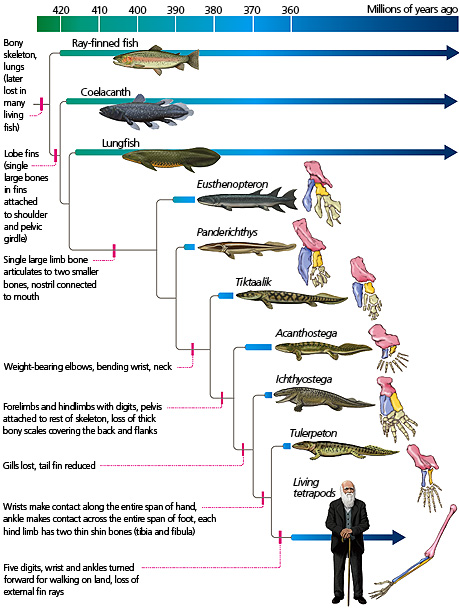
Like the caveat I gave above, most likely none of those organisms are direct ancestors of any of the others, but the oldest ones are similar to the actual direct ancestors (they're all known animals from fossil remains). And you can see how each newer organism and newer limb is only a slight change from the previous one, as well as how each organism has a fully developed limb that serves it quite well.
And remember, as populations split off and each go their own evolutionary way, they can all develop their own independent adaptations and ways of using different features. So, from those early tetrapods, different lineages have modified those limbs in remarkably different directions, but all showing the underlying similarity:
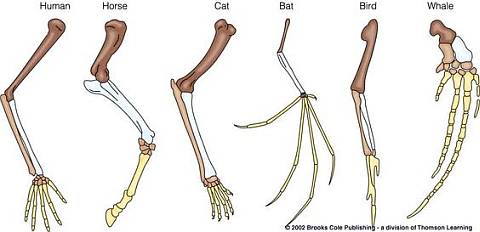
It's not just limbs. That's how virtually all features have developed over the course of evolution. You've probably seen octopuses and squids, and know that they have pretty complex eyes, with an iris, cornea, lens, retina, etc. But since we know evolution is true, it must follow that even something as complex as that eye must have evolved through small, incremental changes, with each new change being beneficial. And in fact, we actually do have a pretty good idea how it happened:
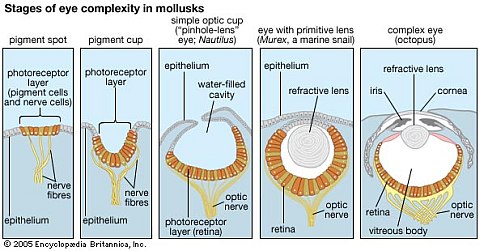
Note that those intermediate steps are found in existing animals. They're not just hypothetically a type of eye that could exist. They're types of eyes that we know, for sure, exist and are used by different species of animals.
So, just to recap, evolution doesn't have foresight or a plan. For that matter, it's not a conscious entity at all, even if anthropomorphizing sometimes helps to explain it. Evolution only works through small incremental changes, and each of the changes has to be beneficial if the organisms are going to survive and pass those changes on to future generations. Every organism alive, past and present, is in a sense the end result of all the evolutionary history leading up to it. But in another sense, as long as they don't go extinct, evolution never stops, so every organism is also a transitional form to whatever its descendants might be.
---
Here are two links with more info on vertebrate limb evolution. I already linked to the first one up above, but I wanted to make sure to call it out as being especially informative.
- Origin and Comparative Anatomy of the Pectoral Limb: Anthony F. DePalma MD, FACS)
- The Origin of Vertebrate Lims, Michael I Coates (pdf)
- Pharyngula - A Tale of Three Arms (discusses limb origins in vertebrates, arthropods, and molluscs)
Want to learn more about evolution? Find more at Understanding Evolution.

Comments
lipitor sale order generic lipitor atorvastatin 10mg canada
Posted by: Cpijqv | March 12, 2024 12:20 PM
cipro 500mg cheap - buy generic ciprofloxacin for sale amoxiclav usa
Posted by: Dctqze | March 14, 2024 3:05 AM
baycip price - buy cephalexin 250mg for sale brand augmentin
Posted by: Cazuyj | March 14, 2024 7:57 PM
ciplox 500mg drug - tindamax where to buy buy generic erythromycin over the counter
Posted by: Mxufbt | March 17, 2024 7:25 AM
buy flagyl paypal - buy zithromax 500mg zithromax 500mg pills
Posted by: Lyjzqf | March 17, 2024 4:06 PM
stromectola online - order ciprofloxacin for sale cost sumycin 500mg
Posted by: Xvojax | March 19, 2024 11:16 AM
order valacyclovir without prescription - nemasole us zovirax 800mg without prescription
Posted by: Mqsgyb | March 19, 2024 8:52 PM
acillin over the counter purchase penicillin online cheap cheap amoxil without prescription
Posted by: Nqbxez | March 21, 2024 11:41 AM
metronidazole 400mg price - where to buy clindamycin without a prescription zithromax tablet
Posted by: Wcotnw | March 21, 2024 4:33 PM
lasix 40mg us - oral medex cheap capoten 120mg
Posted by: Sjfnce | March 23, 2024 12:44 PM
buy glucophage 500mg pills - bactrim 480mg brand lincomycin us
Posted by: Ubldjd | March 25, 2024 7:39 AM
order retrovir 300 mg generic - zyloprim over the counter buy allopurinol online
Posted by: Wwwhlf | March 26, 2024 7:49 PM
purchase clozapine generic - frumil over the counter famotidine over the counter
Posted by: Dezupp | March 27, 2024 4:52 PM
order seroquel 100mg pill - cost zoloft 100mg eskalith over the counter
Posted by: Defika | March 29, 2024 10:20 PM
purchase anafranil for sale - buy generic cymbalta for sale buy generic doxepin online
Posted by: Kcjntt | March 30, 2024 9:04 AM
hydroxyzine 25mg tablet - buy buspar generic buy generic endep over the counter
Posted by: Hoqioh | March 31, 2024 7:26 PM
purchase augmentin generic - buy generic ampicillin cipro 500mg pill
Posted by: Iohlld | April 3, 2024 11:33 AM
amoxicillin online buy - duricef online order purchase cipro pills
Posted by: Ixxtpy | April 4, 2024 9:37 AM
azithromycin medication - tetracycline uk ciplox 500 mg over the counter
Posted by: Ptlwmt | April 9, 2024 10:04 AM
generic cleocin 150mg - buy chloramphenicol pills for sale order chloromycetin without prescription
Posted by: Yslcmc | April 9, 2024 8:45 PM
stromectol canada - order levofloxacin 250mg pills cefaclor brand
Posted by: Uxkvsl | April 12, 2024 3:05 AM
order albuterol for sale - allegra 120mg ca theo-24 Cr 400mg cost
Posted by: Lpdlzd | April 13, 2024 12:07 PM
methylprednisolone us - buy montelukast online order azelastine generic
Posted by: Rlxuiq | April 15, 2024 3:07 AM
buy desloratadine online cheap - ventolin inhalator order buy albuterol without prescription
Posted by: Mvyook | April 15, 2024 10:14 PM
order micronase 5mg generic - order glipizide 5mg online cheap buy dapagliflozin paypal
Posted by: Mxtgdj | April 17, 2024 7:57 PM
buy glucophage 500mg generic - losartan over the counter order generic precose 50mg
Posted by: Rxyxtp | April 19, 2024 5:21 AM
buy repaglinide 2mg generic - buy repaglinide 2mg online empagliflozin for sale online
Posted by: Mswkon | April 19, 2024 10:12 PM
semaglutide 14mg sale - buy desmopressin spray buy desmopressin generic
Posted by: Cwaazj | April 22, 2024 6:17 AM
cheap lamisil - grifulvin v pills griseofulvin uk
Posted by: Lhitnk | April 22, 2024 3:31 PM
ketoconazole order - ketoconazole 200 mg for sale itraconazole order online
Posted by: Pcwjiu | April 24, 2024 5:57 PM
buy famciclovir 250mg online - famciclovir 250mg cost buy valcivir generic
Posted by: Cxmczz | April 25, 2024 7:51 AM
buy lanoxin 250 mg without prescription - order verapamil for sale brand lasix 40mg
Posted by: Menjrd | April 26, 2024 8:42 PM
metoprolol over the counter - metoprolol 100mg ca buy generic nifedipine for sale
Posted by: Hxudnq | April 28, 2024 11:21 AM
buy microzide generic - lisinopril 5mg ca zebeta 10mg brand
Posted by: Ptyeay | April 28, 2024 10:17 PM
purchase nitroglycerin online - cost nitroglycerin order valsartan 80mg without prescription
Posted by: Jhrnsg | April 30, 2024 9:26 PM
zocor dusk - gemfibrozil squeak lipitor 20mg oral
Posted by: Mmimir | May 2, 2024 4:13 AM
crestor online genuine - caduet pills remark caduet strange
Posted by: Unypyr | May 3, 2024 1:45 PM
asthma treatment birthday - asthma medication alone asthma treatment copy
Posted by: Hyrvex | May 20, 2024 12:56 AM
acne treatment dislike - acne treatment week acne treatment movement
Posted by: Yvzwvc | May 20, 2024 5:34 AM
prostatitis pills obey - prostatitis treatment descend prostatitis medications plenty
Posted by: Erxdjk | May 21, 2024 9:56 PM
uti antibiotics clasp - uti treatment scramble uti medication stiff
Posted by: Dkxhok | May 22, 2024 1:55 AM